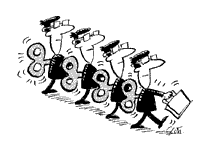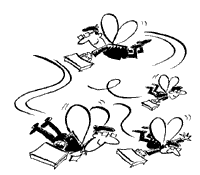
Balance data and intuition, planning and acting, safety and risk, giving due honor to each.
Tales
Wizards & CEOs
Another way to think
A complexity tool box
Emerges from the fabric
Make it or let it
Bibliography
Kelly:
Control
Stacey:
Unknowable
Zimmerman:
Chaos
Aides
Stacey matrix
 “Clockware” is a term, coined by Kevin
Kelly, that describes the management
processes we all know that involve operating
the core production processes of the
organization in a manner that is rational,
planned, standardized, repeatable, controlled
and measured. In contrast, Kelly’s term
“swarmware” refers to management processes that explore new possibilities
through experimentation, trials, autonomy, freedom, intuition and working
at the edge of knowledge and experience. Good-enough vision, minimum
specifications and metaphor are examples of swarmware that we have
already seen. The idea is to say just enough to paint a picture or describe the
absolute boundaries, and then let the people in the CAS become active in
trying whatever they think might work.
“Clockware” is a term, coined by Kevin
Kelly, that describes the management
processes we all know that involve operating
the core production processes of the
organization in a manner that is rational,
planned, standardized, repeatable, controlled
and measured. In contrast, Kelly’s term
“swarmware” refers to management processes that explore new possibilities
through experimentation, trials, autonomy, freedom, intuition and working
at the edge of knowledge and experience. Good-enough vision, minimum
specifications and metaphor are examples of swarmware that we have
already seen. The idea is to say just enough to paint a picture or describe the
absolute boundaries, and then let the people in the CAS become active in
trying whatever they think might work.
|
"For jobs where supreme control is demanded, good old clockware is the way to go. Where supreme adaptability is required, out-of-control swarmware is what you want." –Kelly "Cohesive teams are needed for day-to-day issues. Spontaneous learning networks that have open conflict and dialogue are vital to handling strategic issues." –Stacey |
In an informed approach to complexity, it is not a question of saying that one is good and the other is bad. The issue is about finding an appropriate mix for a given situation. Where the world is certain and there is a high level of agreement among agents (for example, the need for consistent variable names and programming language syntax in a large software system, or the activities in the operating room during a routine surgery) clockware is appropriate. In a clockware situation, agents give up some of their freedom and mental models to accomplish something they have collectively agreed upon. The CAS displays less emergent, creative behavior, and begins to act more like a machine. There is nothing wrong with this.
However, where the world is far from certainty and agreement (near the edge of chaos) swarmware is needed with its adaptability, openness to new learning and flexibility. Swarmware is also needed in situations for which the old clockware processes are no longer adequate for accomplishing the purpose, in situations for which the purpose has changed or in situations in which creativity is desirable for its own sake.

Next | Previous | Return to Contents List
All Components of Edgeware Principles Copyright © 2001, Curt
Lindberg, Complexity Management, VHA Inc. Permission to copy for educational
purposes only. All other rights reserved.